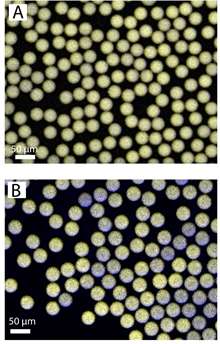Cells get noisy in crowded environments

Bacteria are incredibly small, yet pack an enormous diversity of different molecules such as DNA, mRNA and proteins. Chemists from Radboud University Nijmegen, Eindhoven and Paris now show for the first time that random variations or 'noise' in cellular processes come to exist because of an interplay between the rate of the reaction and its environment. Nature Nanotechnology publishes the results on October 26.
In a living cell, many processes are continuously going on at the same time. Because of that, many different components are present in minute quantities, which inevitably leads to random variations in cellular processes which are also called 'noise' by chemists. Until now, the exact origin of the noise had never been fully explained.
Hundreds of picolitre droplets
Maike Hansen, chemist at Radboud University and first author of the article, explains: 'To investigate the noise phenomenon, we placed DNA molecules in hundreds of tiny picolitre fluid droplets.' All the droplets had the exact same composition, allowing the researchers to investigate them at the same time and look at the noise that originated from the small variations between them.
Slow by viscosity
'We discovered that as the viscosity or the stickiness of the droplets increases, the noise in the cells also increases', Hansen says. 'More into detail, we found out that in viscous environments, of which living cells are an example, the mobility of produced macromolecules like proteins declines. Because of that, the macromolecules are produced faster than they can diffuse away, leading to local reaction hotspots. These hotspots lead to a significant increase in noise, something we confirmed using simulations.'
Resistant bacteria and synthetic cells
When asked about the importance of this finding, Hansen explains: 'We want to understand why cells are different from each other. For instance, why can different bacteria with the same basic information in their DNA be resistant or non-resistant to antibiotics? Those differences can be explained by the small variations that we measured. Furthermore, it is our aim to build a synthetic cell in the lab one day. To achieve this, we have to know all the details about cells and their reactions. So finding out that viscosity is important, is very important to us.'
More information: Maike M. K. Hansen et al. Macromolecular crowding creates heterogeneous environments of gene expression in picolitre droplets, Nature Nanotechnology (2015). DOI: 10.1038/nnano.2015.243
Journal information: Nature Nanotechnology
Provided by Radboud University


















